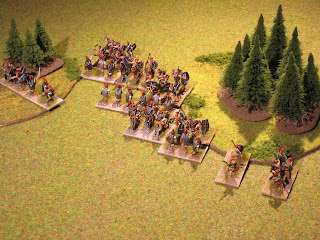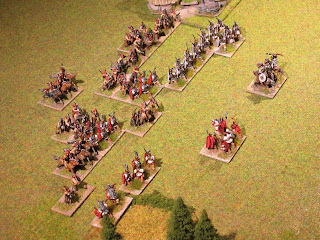This had been posted to the Fanaticus Forum in January
of this year, but changes in Photobucket policies made viewing the camp and its extension no
longer possible. I decided to post this here with new pictures and revise the
text describing its construction.
The style of camp is one used during the Consular
period or Polybian era. making use of the ubiquitous cocktail
stick, string and Milliput.
Materials
required:
Cocktail sticks
Milliput
Standard paper
Contact cement
White glue
Modelling knife
Sewing thread
Cocktail sticks are cut to 15mm (with point) and 5mm lengths.
The shorter pieces would function as spacers placed between the longer pieces and due to the embankment will not be visible.
Cut a 10mm strip of standard paper. The length should
equal the two sections of wall to be constructed. The strip is scored in the
middle (lengthwise) so bending this will form an ‘L’ shaped support.
Alternating lengths of sticks, these are glued with contact
cement. Do this in small sections as you will need ensure that sticks are level
and upright. With a second ‘L’ shaped support, glue this to seal the lower
portion of the wall. After this dries the wall should stand erect.
I use a 3BW x 1BW base for my camps, so the wall
should be set back 5mm from the edge to allow for an embankment. Pencil a line on
the base to indicate the position of the wall and an opening (15mm – 20mm).
You will need to bend the wall section to form a
corner. Cutting a section of paper support (a wedge) with a modelling knife
will help. Glue this to the base and allow drying.
Using Milliput, roll this into lengths equal to your
wall section. It is best to do this four times (two interior and two exterior
sections) as Milliput will lose its tackiness rather quickly.
At this stage, I used an old toothbrush to bring
texture to the embankment so sand or grass will adhere better than on a smooth
surface. Let this dry overnight and the following day you can
add the thread to simulate rope binding the stakes near the top. Spread thin
white glue to bind the thread in place and after this dries, the camp can be given an undercoat.
To finish the piece, I covered the embankment and base with a white glue
and sand mix. Paint the camp and ground to taste and add sparingly some electrostatic grass to the
ground and embankment.
Expanding
the camp.
Two such camps were constructed and included a middle section
measuring 2BW x 3BW. Together, these create a larger "fort" which measures 4BW x 3BW.
The earth colour is Citadel's Angrellan Earth
(Technical) diluted to a 1:5 ratio. Daub the paint on as brushing may
loosen the sand. Dry brushing the earth with Citadel Ceramite White (Base) will pick out stones and "dust" the ground surface.
This has become a standard ground colour for all my
collections.













































